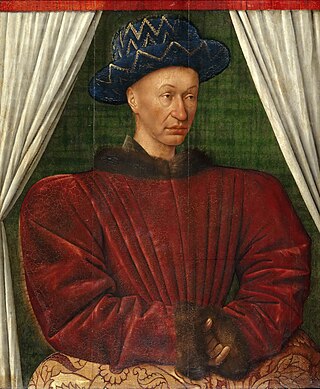| |||||
| Decades: | |||||
|---|---|---|---|---|---|
| See also: | Other events of 1438 History of France • Timeline • Years | ||||
This article relies largely or entirely on a single source .(June 2022) |
| |||||
| Decades: | |||||
|---|---|---|---|---|---|
| See also: | Other events of 1438 History of France • Timeline • Years | ||||
This article relies largely or entirely on a single source .(June 2022) |

Henry VII was King of England from his seizure of the crown on 22 August 1485 until his death in 1509. He was the first monarch of the House of Tudor.

Pope Clement VII was head of the Catholic Church and ruler of the Papal States from 19 November 1523 to his death on 25 September 1534. Deemed "the most unfortunate of the popes", Clement VII's reign was marked by a rapid succession of political, military, and religious struggles—many long in the making—which had far-reaching consequences for Christianity and world politics.

Edward VII was King of the United Kingdom of Great Britain and Ireland and Emperor of India, from 22 January 1901 until his death in 1910.

Charles VII was Prince-Elector of Bavaria from 26 February 1726 and Holy Roman Emperor from 24 January 1742 to his death. He was also King of Bohemia from 1741 to 1743. Charles was a member of the House of Wittelsbach, and his reign as Holy Roman Emperor thus marked the end of three centuries of uninterrupted Habsburg imperial rule, although he was related to the Habsburgs by both blood and marriage.

Charles VII, called the Victorious or the Well-Served, was King of France from 1422 to his death in 1461.

Charles VI, nicknamed the Beloved and later the Mad, was King of France from 1380 until his death in 1422. He is known for his mental illness and psychotic episodes that plagued him throughout his life.

Ferdinand VII was a King of Spain during the early 19th century. He reigned briefly in 1808 and then again from 1813 to his death in 1833. He was known to his supporters as el Deseado and to his detractors as el ReyFelón.

The Sack of Rome, then part of the Papal States, followed the capture of the city on 6 May 1527 by the mutinous troops of Charles V, Holy Roman Emperor during the War of the League of Cognac. Despite not being ordered to storm the city, with Charles V intending to only use the threat of military action to make Pope Clement VII come to his terms, a largely unpaid Imperial army formed by 14,000 Germans, many of Lutheran faith, 6,000 Spaniards and some Italian contingents occupied the scarcely defended Rome and began looting, slaying and holding citizens for ransom in excess without any restraint. Clement VII took refuge in Castel Sant'Angelo after the Swiss Guard were annihilated in a delaying rearguard action; he remained there until a ransom was paid to the pillagers. Benvenuto Cellini, eyewitness to the events, described the sack in his works. It was not until February 1528 that the spread of a plague and the approach of the League forces under Odet de Foix forced the army to withdraw towards Naples from the city. Rome's population had dropped from 55,000 to 10,000 due to the atrocities, famine, an outbreak of plague and flight from the city. The subsequent loss of the League army during the Siege of Naples secured a victory in the War of the League of Cognac for Charles V. The Emperor denied responsibility for the sack and was eventually absolved by Clement VII for the event. On the other hand, the Sack of Rome further exacerbated religious hatred and antagonism between Catholics and Lutherans.

Louis II was Duke of Anjou and Count of Provence from 1384 to 1417; he claimed the Kingdom of Naples, but only ruled parts of the kingdom from 1390 to 1399. His father, Louis I of Anjou—the founder of the House of Valois-Anjou—was a younger son of King John II of France and the adopted son of Queen Joanna I of Naples. When his father died during a military campaign in Naples in 1384, Louis II was still a child. He inherited Anjou from his father, but his mother, Marie of Blois, could not convince his uncles, John, Duke of Berry and Philip II, Duke of Burgundy, to continue her husband's war for Naples. The Provençal nobles and towns refused to acknowledge Louis II as their lawful ruler, but Marie of Blois persuaded them one after another to swear fealty to him between 1385 and 1387.

Joan of Arc at the Coronation of Charles VII is an 1854 painting by Jean-Auguste-Dominique Ingres. It is now in the Louvre Museum in Paris.
Events from the year 1461 in France
Events from the year 1437 in France
Events from the year 1439 in France
Events from the year 1440 in France
Events from the year 1429 in France
Events from the year 1446 in France
Events from the year 1435 in France
Events from the year 1433 in France
Events from the year 1447 in France
Events from the year 1452 in France.